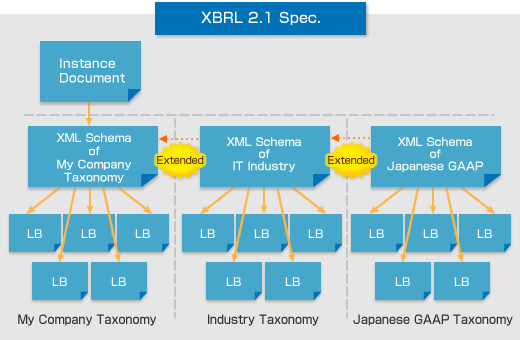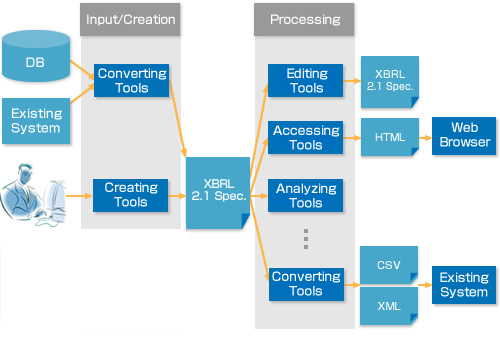Information of event
Technology of XBRL
| |1|Technology of XBRL -2| | |
XBRL was originally introduced as a general business reporting language and developed in the area of XBRL FR (Financial Report) for presentation of disclosed information especially in financial accounting. XBRL FR taxonomies are now developed in terms of each accounting standards and fields by XBRL organizations in each country. In Japan, some taxonomies were developed ahead of the world, one for a tax return by the National Tax Administration Agency, one for timely disclosure by Tokyo Stock Exchange, and one for corporate information disclosure by Financial Services Agency. A number of systems using XBRL documents created with these taxonomies are established and put to practical use.
In addition to the taxonomies meeting each company's accounting standards, taxonomies for industries and companies are also can be defined and extended according to the individual businesses.
In response to the XBRL feature, a XBRL taxonomy handling internal accounting information is discussed and developed. This is called XBRL GL (Global Ledger), in which a global and fundamental taxonomy is developed and some option modules are combined on it.
It is expected that XBRL will become a standard covering boarder business area by enabling its use not only for financial report area but also for internal accounting information.
The following describes the details of creating and using business reporting information with XBRL.
| <When creating business reporting information> |
|---|
|
Figure 2 illustrates the description above.
Figure 2 An Example of Composing XBRL 2.1 Spec.

In this example, "Japanese GAAP Taxonomy" represents basic taxonomy, and "Industry Taxonomy" represents industrial classified taxonomy, and "My Company Taxonomy" represents your company's taxonomy.
| <When using business reporting information> |
|---|
| Business reporting information created as XBRL document can be used for various applications using XML related technologies such as XLink and XSLT and dedicated applications. You can process XBRL document as an input data, and extract the target values of titles of account or view labels, and analyze or utilize the information extracted. You can also convert these informations into different kinds of formats such as HTML, PDF, CSV, and other XML format as necessary. The information disclosed with XBRL format is utilized by users (institutional investors, individual investor, financial institutions, supervisory authorities, regulatory agencies, audit corporations, etc.) in many ways. XBRL taxonomies play a big role in both creating and utilizing business reporting information. XBRL taxonomies include definition information of titles of account as the information required for creating, processing, viewing, comparing, and analyzing instance documents. In order to put XBRL to practical use and promote it, it is required that continuous improvement on creating and promoting common XBRL taxonomies used as country level or industry level and individual XBRL taxonomies used for particular purpose on business reporting information. In addition, the promotion of maintenances/promotions of designing and editing tools for instance documents and XBRL taxonomies corresponding to 2.1 and collaboration with related accounting treatment software are also needed. |
Figure 3 shows overview of tools and software required for processing XBRL documents (XBRL taxonomies and instance documents).
Figure 3 A Series of XBRL2.1 Tools

![]()
| |1|Technology of XBRL -2| |